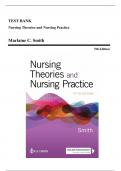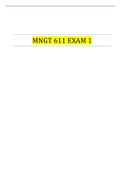TEST BANK
Nursing Theories and Nursing Practice
Marlaine C. Smith
5th Edition
,Table of Contents
Chapter 01 Nursing Theory and the Discipline of Nursing 1
Chapter 02 A Guide for the Study of Nursing Theories for Practice 4
Chapter 03 Choosing, Evaluating, and Implementing Nursing Theories for Practice 6
Chapter 04 Florence Nightingale’s Conceptualizations of Nursing 9
Chapter 05 Early Conceptualization About Nursing 11
Chapter 06 Nurse–Patient Relationship Theories 14
Chapter 07 Dorothy Johnson’s Behavioral System Model 18
Chapter 08 Dorothea Orem’s Self-Care Deficit Nursing Theory 21
Chapter 09 Imogene King’s Theory of Goal Attainment 24
Chapter 10 Callista Roy’s Adaptation Model 27
Chapter 11 Betty Neuman’s Systems Model 30
Chapter 12 Helen Erickson, Evelyn Tomlin and Mary Ann Swain’s Theory of Modeling
and Role-Modeling 33
Chapter 13 Barbara Dossey’s Theory of Integral Nursing 37
Chapter 14 Martha E. Rogers’ Science of Unitary Human Beings 40
Chapter 15 Rosemarie Rizzo Parse’s Humanbecoming Paradigm 43
Chapter 16 Margaret Newman’s Theory of Health as Expanding Consciousness 46
Chapter 17 Madeline Leininger’s Theory of Culture Care Diversity and Universality 49
Chapter 18 Jean Watson’s Theory of Unitary Caring Science and Theory of Human Caring 53
Chapter 19 Theory of Nursing As Caring 56
Chapter 20 Afaf Meleis Transitions Theory 59
Chapter 21 Katharine Kolcaba’s Comfort Theory 62
Chapter 22 Joanne Duffy’s Quality-Caring Model© 65
Chapter 23 Pamela Reed’s Theory of Self-Transcendence 68
Chapter 24 Patricia Liehr and Mary Jane Smith’s Story Theory 71
Chapter 25 The Community Nursing Practice Model 74
Chapter 26 Rozzano Locsin’s Technological Competency as Caring in Nursing 77
Chapter 27 Marilyn Anne Ray’s Theory of Bureaucratic Caring 80
Chapter 28 Troutman-Jordan’s Theory of Successful Aging 83
Chapter 29 Barrett’s Theory of Power as Knowing Participation in Change 86
Chapter 30 Marlaine Smith’s Theory of Unitary Caring 89
Chapter 31 Kristen Swanson’s Theory or Caring 92
Chapter 32 Adeline Falk-Rafael’s Critical Caring Theory 94
Chapter 33 Katie Eriksson’s Theory of Caritative Caring 97
,______________________________________________________________________________________________
Test Bank - Nursing Theories and Nursing Practice, 5th Edition (Smith, 2020)
Chapter 1: Nursing Theory and the Discipline of Nursing
MULTIPLE CHOICE
1. The purpose of theory is to:
A. Explain experience.
B. Describe relationships.
C. Project outcomes.
D. All of the above.
ANS: D
2. Members of a community of scholars share a commitment to all of the following except:
A. Values.
B. Knowledge.
C. Geographic location.
D. Processes.
ANS: C
3. _________________ and _______________ structures are essential to any discipline and
are inherent in nursing theories.
A. Paradigm and metaparadigm.
B. Syntactical and conceptual.
C. Middle and grand.
D. Language and symbol.
ANS: B
4. Books and periodicals are examples of:
A. Communication networks.
B. Heritage of literature.
C. Nursing organizations.
D. Nursing discipline.
ANS: B
5. The basic building blocks of theories are:
A. Concepts and their definitions.
B. Statements of relationships.
C. Concepts and statements of relationships.
D. Empirical indicators.
ANS: C
6. Nursing theories:
A. Are discovered in nature.
B. Serve as exact representations of reality.
C. Are invented by humans.
D. Cannot be modified.
______________________________________________________________________________________________
1|Page
,______________________________________________________________________________________________
Test Bank - Nursing Theories and Nursing Practice, 5th Edition (Smith, 2020)
ANS: C
7. A paradigm is defined as a:
A. Worldview.
B. General framework.
C. Set of shared perspectives held by members of a discipline.
D. All of the above.
ANS: D
8. The dependence of nursing theory development on human imagination is an attribute of
nursing as a(n):
A. Occupation.
B. Discipline.
C. Vocation.
D. Profession.
ANS: B
9. The primary purpose of nursing theory is to:
A. Structure nursing knowledge.
B. Demonstrate creativity in nursing.
C. Guide the thinking about, being, and doing of nursing.
D. Organize nursing curricula.
ANS: C
10. The first nursing theorist who identified the importance of theory in nursing was:
A. Virginia Henderson.
B. Hildegard Peplau.
C. Lydia Hall.
D. Florence Nightingale.
ANS: D
11. The most abstract level of knowledge is the:
A. Paradigm.
B. Metaparadigm.
C. Theory.
D. Concept.
ANS: B
12. Statements of enduring values or beliefs are considered:
A. Conceptual models.
B. Philosophies.
C. Grand theories.
D. Practice theories.
ANS: B
______________________________________________________________________________________________
2|Page
,______________________________________________________________________________________________
Test Bank - Nursing Theories and Nursing Practice, 5th Edition (Smith, 2020)
13. Theories that include specific concepts, are broad enough to be useful in complex situations,
and can be empirically tested are called:
A. Grand theories.
B. Middle-range theories.
C. Practice-level theories.
D. Nursing theories.
ANS: B
14. Theories that have the most limited scope and level of abstraction that are useful in within a
specific range of nursing situations are called:
A. Grand theories.
B. Middle-range theories.
C. Practice-level theories.
D. Nursing theories.
ANS: C
15. The name for the boundaries or focus of a discipline is:
A. Imagination.
B. Domain.
C. Tradition.
D. Value.
ANS: B
TRUE/FALSE
16. Every discipline has a unique focus that directs inquiry and distinguishes it from other fields
of study.
ANS: T
17. Theories are not discovered in nature but are human inventions.
ANS: T
18. Science generally evolves as a smooth, regular, continuing path of knowledge development
over time.
ANS: F
19. Early nursing theorists relied on definitions of theory from nursing practice to guide the
development of theories within nursing.
ANS: F
20. The best test of any nursing theory is its usefulness in professional practice.
ANS: T
______________________________________________________________________________________________
3|Page
,______________________________________________________________________________________________
Test Bank - Nursing Theories and Nursing Practice, 5th Edition (Smith, 2020)
Chapter 2: A Guide for the Study of Nursing Theories for Practice
MULTIPLE CHOICE
1. The scope of nursing practice is:
A. Known and static.
B. Continually being expanded.
C. Determined only by individual researchers.
D. Important only to nurses with advanced degrees.
ANS: B
2. The question “What does the nurse attend to when practicing nursing?” relates to which of
the following areas of the theory guide?
A. How nursing is conceptualized.
B. The context of theory development.
C. Authoritative sources.
D. Overall theory significance.
ANS: A
3. Nursing theorists and nurses in practice:
A. Are interested in related but different phenomena.
B. Do not see nursing in the same context.
C. Think and work with the same phenomena.
D. Require the same knowledge and skills.
ANS: C
4. The study of nursing theory:
A. Is a simple, short-term endeavor.
B. Can be easily undertaken.
C. Requires a continuing commitment.
D. Is not essential for expert nursing practice.
ANS: C
5. The question “What nursing societies share and support work of the theory?” relates to
which of the following areas of the theory guide?
A. How nursing is conceptualized.
B. The context of theory development.
C. Authoritative sources.
D. Overall theory significance.
ANS: C
6. The question “Is the theory used to guide programs of nursing education?” relates to which
of the following areas of the theory guide?
A. How nursing is conceptualized.
B. The context of theory development.
______________________________________________________________________________________________
4|Page
,______________________________________________________________________________________________
Test Bank - Nursing Theories and Nursing Practice, 5th Edition (Smith, 2020)
C. Authoritative sources.
D. Overall theory significance.
ANS: D
MULTIPLE RESPONSE
7. Using the Guide for Study of Nursing Theory for Use in Practice, which of the following
questions are asked? (Select all that apply):
A. What is the purpose of nursing?
B. What judgment guides choosing a nursing theory?
C. What are the major theoretical influences on this theory?
D. What are the major internal influences that guide the significance of nursing
theory?
E. What are the major external influences on development of the theory?
ANS: A, C, E
TRUE/FALSE
8. The guide for the selection of nursing theory presented in your text is a set of questions that
facilitate reflection and exploration in the study of nursing theory that can lead to the
selection of a nursing theory for use in your practice.
ANS: T
9. One criterion for hospitals seeking magnet hospital status is selection of a theoretical model
for nursing practice.
ANS: T
10. It is not necessary or desirable for the study and use of nursing theory to have roots in the
everyday practice of nursing.
ANS: F
11. Key ways to study nursing include analysis and evaluation.
ANS: T
______________________________________________________________________________________________
5|Page
,______________________________________________________________________________________________
Test Bank - Nursing Theories and Nursing Practice, 5th Edition (Smith, 2020)
Chapter 3: Choosing, Evaluating, and Implementing Nursing Theories for Practice
MULTIPLE CHOICE
1. The primary purpose of nursing theory is to:
A. Improve nursing practice.
B. Control health-care costs.
C. Justify nursing costs.
D. Establish nursing as a discipline.
ANS: A
2. Nursing practice is essential for all of the following EXCEPT:
A. Developing nursing theory.
B. Testing nursing theory.
C. Refining nursing theory.
D. Discovering nursing theory.
ANS: D
3. Nurses working together as colleagues often realize that:
A. Their views of nursing are not compatible.
B. They share the same values and beliefs.
C. The study of nursing theory does not enhance their work.
D. None of the above.
ANS: B
4. Responses to guiding questions about theory in practice can be found in the following
resources:
A. Nursing literature.
B. Audiovisual sources.
C. Electronic sources.
D. All of the above.
ANS: D
5. How we come to know the science of nursing and other disciplines that are used in nursing
practice is described as:
A. Empirical knowing.
B. Personal knowing.
C. Emancipatory knowing.
D. Aesthetic knowing.
ANS: A
6. How we come to know the moral component affecting choices within the complexity of
health care that guide day-to-day actions in nursing practice is described as:
A. Empirical knowing.
B. Personal knowing.
______________________________________________________________________________________________
6|Page
,______________________________________________________________________________________________
Test Bank - Nursing Theories and Nursing Practice, 5th Edition (Smith, 2020)
C. Ethical knowing.
D. Emancipatory knowing.
ANS: C
7. Striving to know the self and to actualize authentic relationships between the nurse and the
one nursed is defined as:
A. Empirical knowing.
B. Personal knowing.
C. Ethical knowing.
D. Aesthetic knowing.
ANS: B
8. Cultivating awareness about how social, political, and economic forces shape assumptions
and opinions about knowledge and truth is defined as:
A. Personal knowing.
B. Ethical knowing.
C. Emancipatory knowing.
D. Aesthetic knowing.
ANS: C
9. Which of the following questions should be asked when selecting a guide for theory
evaluation?
A. Is the theory a grounded theory?
B. Is the theory a grand or middle-range nursing theory?
C. Is personal knowing part of the theory?
D. Is reflective practice part of the nursing theory?
ANS: B
MULTIPLE RESPONSE
10. When reflecting and choosing a nursing theory for practice, which factors are important?
(Select all that apply):
A. Choosing three basic criteria to guide evaluation of nursing theory.
B. Enduring values.
C. Critical reflection about whether the nursing theory works.
D. Cultivating awareness and appreciation.
E. Creating values and the nursing situation.
ANS: B, D, E
11. Which of the following are used in the process of adoption and implementation of theory-
guided practice within units or organizations? (Select all that apply):
A. Knowing and reflecting on the nursing evaluation tool.
B. Creating a plan for evaluation.
C. Selecting the theory or model to be used in practice.
D. Launching the initiative.
E. Cultivating awareness and appreciation of the theory in practice.
______________________________________________________________________________________________
7|Page
, ______________________________________________________________________________________________
Test Bank - Nursing Theories and Nursing Practice, 5th Edition (Smith, 2020)
ANS: B, C, D
TRUE/FALSE
12. One of the most urgent issues facing the discipline of nursing is the artificial separation of
theory and practice.
ANS: T
13. Theories of any professional discipline are useless if they do not have an impact on practice.
ANS: T
14. Historically, nursing has always been distinctly separate from the medical model.
ANS: F
______________________________________________________________________________________________
8|Page






